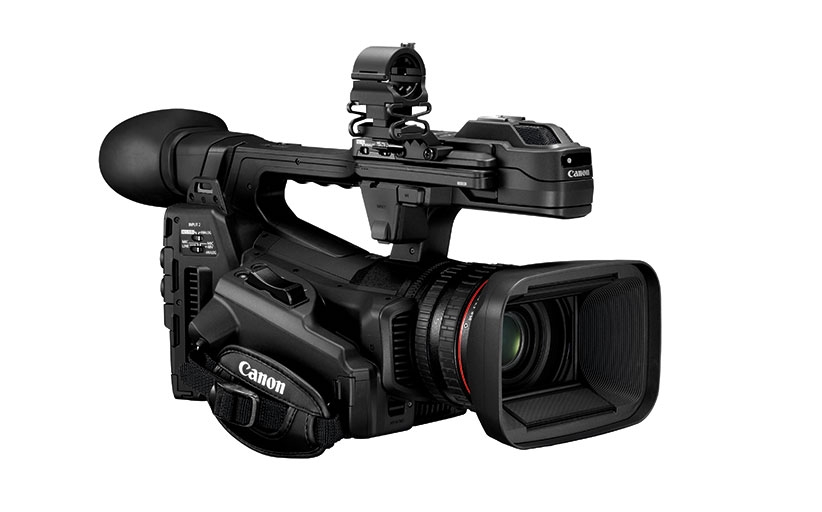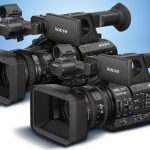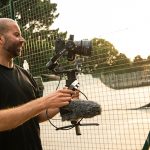
Canon’s camcorder flagship
The successful XF range of broadcast and streaming cameras is joined by the high-resolution XF705
Words / Julian Mitchell
Canon’s XF range has always been great for workhorse cameras – the form factor of fixed lens and multiple buttons is a busy shooter’s dream. We’ve loved the way they compressed footage at high rates with accessible codecs, and stored the resulting MXF files on nice, freely available, relatively cheap media – this time SD cards instead of CompactFlash.
The latest model is the XF705, with improvements that are totally predictable but nonetheless impressive. Using the XF-HEVC codec you can now shoot UHD 3840×2160 at 50p and in 4:2:2 10-bit to SD cards. We used Lexar 1000x SD cards, which can record up to 150 MB/s, while the XF705 tops out at 160Mbps, and it worked well. HEVC stands for High Efficiency Video Coding, which is the way 4K is compressed for delivery to homes.
Our 64GB Lexar cards gave us around 110 minutes in 4K from the two SD card slots on the side of the body in the 160Mbps mode.
You can shoot with Canon’s XF-AVC codec if you’re not quite ready for 4K UHD, but resolution and quality is down to HD with a 4:2:0 8-bit signal. As you can choose 1920×1080 using the HEVC option, you shouldn’t really need XF-AVC. The only reason would be if your NLE couldn’t deal with the new HEVC codec, which initially might
be a problem.
Canon is using a 1.0-type CMOS sensor and DIGIC DV6 processor to deal with the extra processing needed for the big jump in resolution and other data-hungry processing. The body also has some large air intakes to keep things cool, but ours was a pre-production model so this might change when you order yours.
Arguably, with this new 1.0-type sensor you can start experimenting with depth-of-field to a certain degree, especially when you use the monitor’s touchscreen to focus – another box ticked. You can also consider the XF705 as a possible back-up for some of the larger sensor cameras.
In front of the sensor is a fixed L-series Canon lens with a 15x optical zoom range, and a maximum aperture of f/2.8 that drops to f/4.5 at longer zoom settings. The wide-angle is equivalent to 25.5mm and the telephoto is equivalent to a lengthy 382.5mm. There is also five-axis image stabilisation, including the well-known Powered IS, which tries to simulate a tripod mode and does a pretty good job of it. This lovely L lens has three independent control rings with end stops to ensure the camcorder has a decent level of manual control.
This lens is one of the truly standout features of the XF705 and, as it has done before, Canon has sought advice from broadcasters and cinematographers on the design of this camera. The lens handling is where this is most obvious. The focus ring can be used as a true manual control with a calibrated scale and end stops. However, if you press a button and turn the lens barrel behind the focusing ring, the calibrated scale disappears and the focusing ring becomes an ‘endless encoder’, with both manual and auto-focus. If you want to use the lens ring as a zoom ring instead of the rocker, there is a simple slider control directly behind it.
While on the subject of autofocus, the XF705 features Canon’s amazing, wonderful and unique Dual Pixel autofocus. This system is so brilliant it’s persuaded many an anti-autofocus shooter to use it. On the XF705, this provides the normal accurate and fast autofocus with touch focus control, face-detection AF and object tracking. You also get a graphical guide to support accurate focusing when making manual adjustments.

(Above) Items in the box include shoulder pad, lens hood and barrier, battery pack and charger, mic holder, eye cup and shoulder strap
The attention to detail isn’t limited to the lens controls. There are plenty of dedicated buttons for zebra, peaking, image stabilisation and so on – all well placed and logical. You also get a motor-driven ND filter with three densities: ND 1/4, ND 1/16 and ND 1/64.
With the years of experience that Canon had for this form factor, the hands-on control is as you would expect it to be, with everything at your fingertips. There are semi-duplicate record controls up top, near the monitor and on the fixed grip. The monitor itself is available either side of the camera and has a tilt-and-slide motion to swap it over and indeed to put it away, much like the Panasonic AG-DVX200.
The rocker switch has a magnification button beside it, and on top you will find media controls and the built-in microphones. Two XLRs are available, with Input 1 nearer the lens and Input 2 at the back. Maybe this has something to do with the extra connections that crowd the back of the camera.
Included – and very new for this type of camera – is the 12G-SDI, which is four times the bandwidth of 3G-SDI and will allow 4K IP streaming through one cable, thanks to the handy on-board ethernet connection. The camera also has Wi-Fi on board for lower resolution streaming.
The XF705 is able to livestream video using IP transmission in either the H.265/HEVC or H.264/AVC encoding format. Live H.265 streams (16Mbps at 59.94p) can be used to distribute either 4K UHD or Full HD data efficiently to a variety of platforms. You also get HDMI, timecode and headphone, among others, at the back.
However, perhaps the standout feature of the XF705 is the way Canon has implemented HDR into shooting options. As presets, you now have the option of BT. 709 all the way to HLG, PQ and Canon Log 3.
It’s also worth mentioning that, for the first time in the XF series camera range, the XF705 supports Canon Log 3. This feature offers
13 stops of dynamic range, smooth midtones and preserving details in the shadows.

“The Dual Pixel AF has turned many a manual focus traditionalist into an autofocus evangelist”
The verdict
A do-it-all camera with the benefits of a long and fast zoom, high bitrate 4K output, easy streaming technology and instant HDR footage.
With a 1.0-type sensor you’re not going to get wafer-thin depth-of-field, but you can get decent bokeh and, of course, a very modern, high-resolution camcorder that is ideal for run-and-gun filming, documentaries or event coverage.
The Dual Pixel AF is a stunner, especially if you’ve never used it before. It’s turned many a manual focus traditionalist into an autofocus evangelist.
At £6999 it’s not cheap, but is a solid workhorse packed with the latest technology, and should provide great service for years. One slight let-down is the frame rate: at 50/60fps it gives just half speed while many rivals offer 100 or 120fps. But it’s one of the first pro cameras to offer the H.265 codec which gives space-saving for 4K files, along with HDR options built on, so you’ll be relatively future-proofed as these formats become more popular.
How it rates
| Features | 9/10 | Canon knows what working filmmakers really need, and has built a camera to suit |
| Performance | 8/10 | The new internal codec is a big improvement, and the 4K 10-bit 4:2:2 is a stunner |
| Handling | 9/10 | It’s built for ease of use and it shows. All the controls are where they should be |
| Value for money | 8/10 | Expensive for a fixed-lens camcorder but it does offer lots of spec and performance |
| OVERALL RATING | 9/10 | As a documentary camera it delivers on all counts, with great AF, stunning image quality, a great lens and ease of use |
Pros: Canon’s best camcorder, with 4K and HDR ready to go
Cons: No super slow motion and lack of H.265 support at the moment
Specifications
Price: £6999/ $6999
Sensor: 1.0-type CMOS, 13.4 megapixels, Dual DIGIC DV6 processor
Formats: 4K and HD, XF-HEVC 4:2:2 10-bit H.265, XF-AVC 4:2:0 8-bit H.264
Picture settings:
Normal, BT. 709, BT. 2020, Canon Log 3, HLG, Wide DR.
Frame rates: 60/ 50/ 30/ 25p depending on region
Storage: 2x SDXC slots
Lens: 15x optical, 30x digital zoom. 8.3-124.5mm/f/2.8-4.5 (equivalent to 25.5-382.5mm)
Focus: Dual Pixel CMOS AF
Image stabilisation: Optical and in-body
ND: 3-stage optical ND
Output: HDMI, 12G-SDI
Shutter range:
1/2-1/2000sec (50p)
Dynamic Range: 12 stops in Canon Log 3 or Wide DR
Screen: 10.1cm/4-inch LCD capacitive touch panel
Audio: Integrated microphones, 2x XLR inputs with phantom power support
Dimensions (WxHxD): 191x258x433mm/7.5×10.2x17in
Weight: 2660g/5.86lb

This feature originally appeared in the Spring 2019 edition of Pro Moviemaker.










